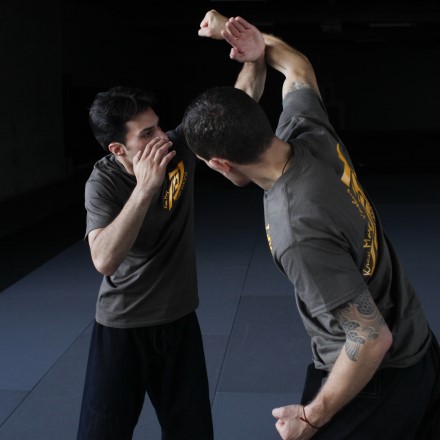Intercepting & Blocking Attacks

Blocking Articles
- Blocks As Attacks
- Proactive Vs Reactive Blocking
- Block or Cover?
- Blocks As Attacks (Part 2)
- Body Defense
- Slipping
- Working with Instinct
All Krav Maga Articles
Intercepting & Blocking Punches, Kicks and Weapon Attacks
There are many different ways of defending against punches and strikes. One way is simply to harden and toughen the body up so that you learn how to manage the pain/impact of being punched and kicked; this is something that many Karate systems do, such as Okinawan Uechi-Ryu, and Japanese Kyokushin e.g., they condition the legs, arms, and body to be able to withstand being hit etc. This method may work for the body however it is not such an effective strategy for dealing with punches to the face, and although it is possible to strengthen the neck to lessen the chance of concussion, it would be impossible to do so to the extent where it would be impossible for anybody to land a knock-out punch/blow etc. It is good to have a degree of body conditioning, and so be able to continue in a fight when hit, but such conditioning should never be a primary strategy for dealing with punches and kicks etc. A similar but slightly more sophisticated strategy would be to absorb or ride a punch, kick, knee, or elbow etc. Rather than just take it, this strategy would involve moving with the blow t reduce its power and impact. This is a useful skill to have, as there may be times when if caught off-guard, this may be the only thing you can do. However, once again it should not be a primary strategy. Another way to deal with striking is to cover, using a less painful and injurious part of the body to absorb the strike, such as covering the face/head when punched, so that the arm takes the brunt of the force; a tactic such as this could be employed whilst “riding” the punch.
Two other strategies for dealing with striking, is to block and intercept a strike, and to move away from it so that you are out of range. Krav Maga blocking encompasses both of these i.e., there is a hand-defense (the block), and a body-defense (the movement away from the strike). Together, these allow for each part to be performed sub-optimally, whilst still achieving the objective of not getting hit. A significant advantage that blocking and moving have over absorbing, riding, and covering strikes is that this strategy and approach will also work against weapon attacks e.g., whilst covering” and taking a knife in the arm might be preferable to being stabbed in the arm, it would be better still if the knife could be intercepted and stopped from reaching its target. When it is considered that it is often impossible to distinguish the movement of a weapon from an empty-handed attack – a straight stab to the face will resemble a Jab or a Cross, and a fast slash may look like a clumsy “haymaker” – blocking should become the default method for dealing with attacks. That does not mean that the other methods don’t have their time and place but rather that blocking and intercepting strikes gives us the greatest insurance from the largest number of possible attacks.